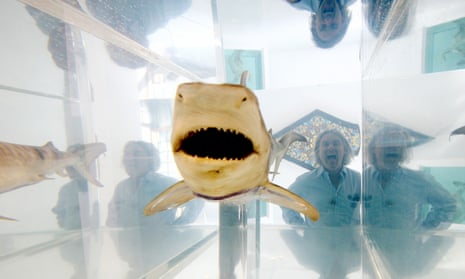Two events changed the face of Britain in 1997. One was the landslide victory for New Labour in the general election on 1 May. The other was Sensation: Young British Artists, an exhibition from the Saatchi Gallery that opened in September at the Royal Academy in London.
To a nation basking in Tony Blair’s (long) honeymoon with the electorate, the Saatchi show seemed an image of a new Britain that was shoving conservatism aside. Here was new art for a new age, from Gavin Turk’s self-portrait as Sid Vicious to Tracey Emin’s tent. Yet just as New Labour was dominated by Blair’s personality, Sensation was dominated by Damien Hirst, whose dead animals in vitrines were the most outrageous and the most serious art in the entire show.
Where are they now? Well, Blair and Hirst are both very rich. But neither is in tune with the spirit of that age. Hirst has been savagely criticised for his later work, which is seen as symbolic of the crass, the cynical and the money grabbing. Blair, meanwhile, is about to see everything he worked for in the Labour party reversed, as the last shreds of his election-winning ideology fall before the Corbynista revolt.
Is time running backwards? It is a question worth asking, because Hirst and Blair, young British art and New Labour, claimed to be the very definition of the modern. In politics, it seems that Blairism is very old-fashioned indeed. But if we look at the parallel with art, things become much less clearcut.
Critics rejected young British art long before voters rejected New Labour. (Indeed, voters never did reject Blair; they rejected Gordon Brown and Ed Miliband.) Even when Sensation opened, the most exciting years of 1990s British art were already over, and Hirst would soon be flirting with, then seriously dating and going to bed with kitsch. Savvy art-world folk, including Charles Saatchi, were searching for the next big thing, the next wave of innovation in British art.
That wave has never come. What has happened in British art since 1997 is both awe-inspiring and angering. The breakthrough of the Hirst generation made modern art popular in Britain in a way perhaps no country has ever experienced. This phenomenon continues today, with Banksy’s Dismaland for example, clearly being a massive pop-cultural phenomenon. But where is the artistic strength to back up the hype and excitement?
Artists consciously rebelled against Hirstonomics long before anyone imagined a Labour party led by Jeremy Corbyn. But the result is a decline in quality. We’ve gone from the provocative, controversial newness of the YBAs to a string of arts and crafty, or worthily “political”, or drably technocratic mini-movements that, when the history books are written, will add up to a very mediocre second wave of contemporary British art. It does not matter how many witty putdowns Grayson Perry directs at Damien Hirst. The biting early work of Hirst will always matter more.
Comparing politics and art provokes a troubling thought that we are entering a seriously conservative age. Everyone is rejecting the new in different ways. The 1990s were boldly transformative. New art and New Labour symbolised and shaped a Britain that was brazenly modern. The old was scorned. But now, we have a Conservative government again while the left wants to bring back the 70s. Or earlier.
In this age of looking backwards, I find myself nostalgic not for nationalised industries or Tony Benn’s pipe, but the day I walked into the Saatchi Gallery and saw a tiger shark swim towards me through formaldehyde. Those were the days, when we lived in modern Britain.

